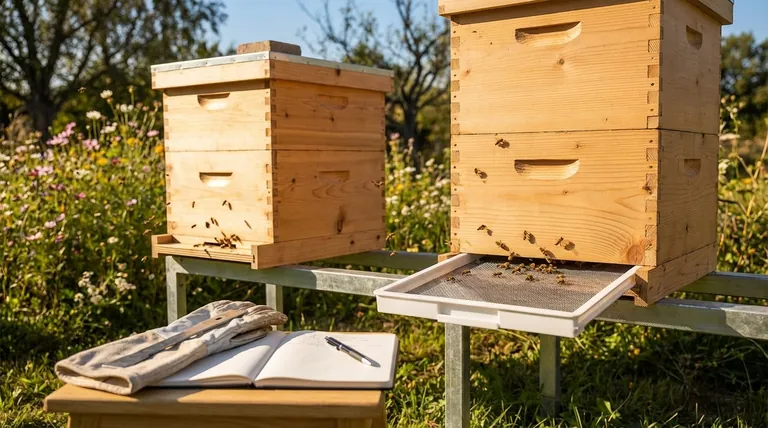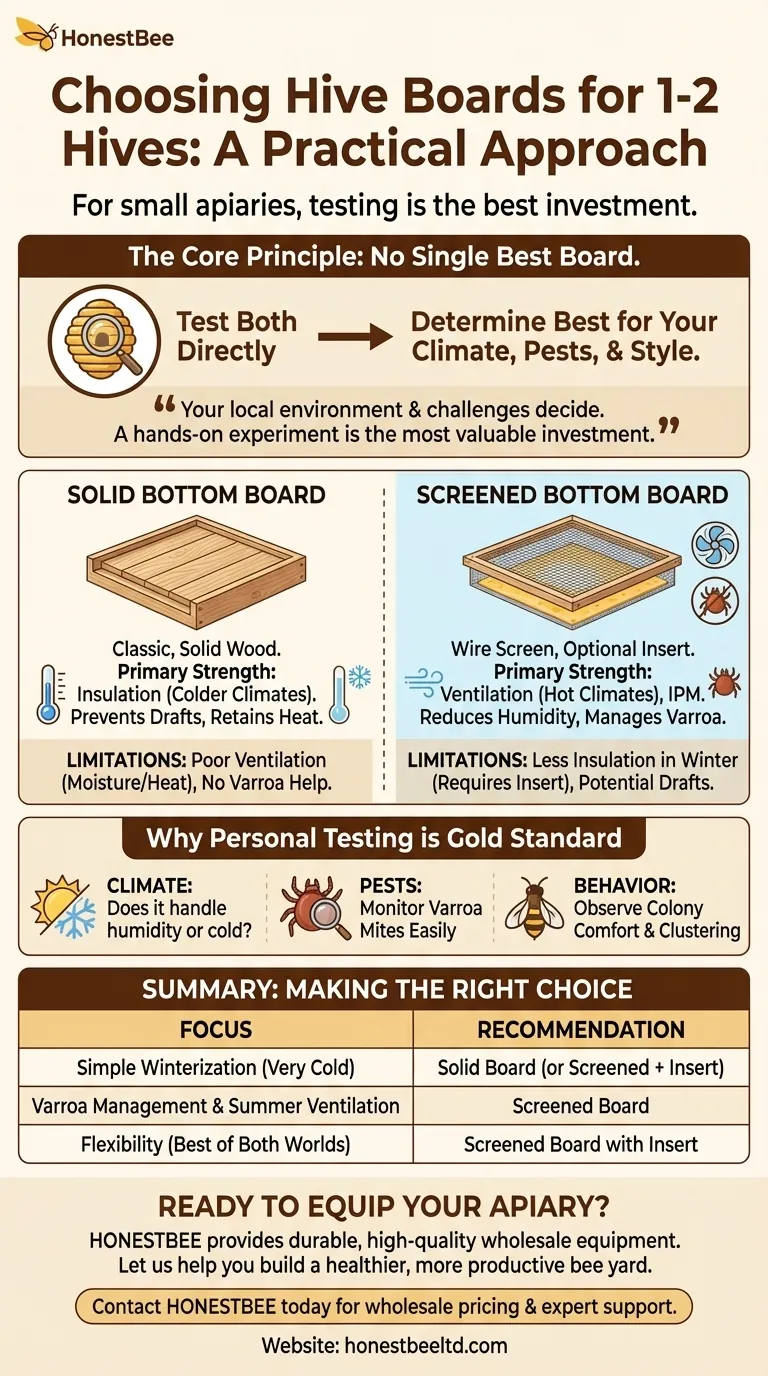For a beekeeper with only one or two hives, the most effective approach is to make a small investment in one of each primary type of hive board. Testing them directly on your own hives is the only definitive way to determine which performs best for your specific climate, pest pressures, and management style.
The core principle is that there is no single "best" hive board for everyone. Your local environment and specific colony challenges are the deciding factors, making a small, hands-on experiment the most valuable investment you can make.

Understanding the Role of the Hive Board
A hive board, also known as a bottom board, serves as the floor of the beehive. It is a critical component that influences ventilation, pest management, and temperature regulation within the colony. The choice you make here has a direct impact on the health and productivity of your bees.
The Solid Bottom Board
This is the traditional, classic design. It is a simple, solid piece of wood that completely closes off the bottom of the hive from the outside environment.
Its primary strength is insulation. In colder climates, a solid board helps the colony retain heat more effectively during the winter, reducing the amount of energy (and honey) they must consume to stay warm.
The Screened Bottom Board
Also known as an Integrated Pest Management (IPM) board, this design features a durable wire screen that makes up most of the floor. It is often paired with a removable plastic or wood insert, called a "sticky board."
The main advantage is ventilation. The screen allows for superior air circulation, which helps reduce humidity in hot climates and prevents the hive from overheating. It is also an invaluable tool for managing Varroa mites, as mites that fall off the bees can drop through the screen and out of the hive.
Why a Personal Test is the Gold Standard
The advice to try both types stems from the fact that beekeeping is intensely local. A technique that works perfectly in a hot, humid region may be detrimental in a cold, dry one.
Evaluating for Your Climate
A hands-on test allows you to observe firsthand. Does the screened board provide necessary ventilation during your humid summers? Does the solid board give your bees a noticeable edge during a harsh winter? Seeing the results in your own apiary is more valuable than any generalized advice.
Assessing Pest Management Needs
Varroa mites are a significant threat to honeybees. A screened bottom board allows you to easily monitor the "mite drop" on a sticky board, giving you crucial data on the level of infestation within your hive without intrusive inspections. For many beekeepers, this feature alone makes it the superior choice.
Observing Colony Behavior
With one of each type, you can compare colonies side-by-side. You may notice differences in behavior, such as how the bees beard on the front of the hive on hot days or how they cluster in the winter. This direct observation provides clear insight into their comfort and well-being.
Understanding the Trade-offs
Neither option is perfect, and understanding their inherent weaknesses is key to making an informed decision.
Solid Board Limitations
The primary drawback of a solid board is poor ventilation. This can lead to excessive moisture buildup, especially in winter, and overheating in the summer. It also offers no passive help in the fight against Varroa mites.
Screened Board Limitations
In cold climates, a screened board provides less insulation. A winter draft can be stressful for the colony. This is why most screened boards come with a removable insert that can be slid in during the winter to function like a solid board.
Making the Right Choice for Your Hives
Your goal is to choose the equipment that gives your bees the best chance to thrive in your specific location.
- If your primary focus is simple winterization in a very cold climate: A solid bottom board may offer a slight advantage in heat retention, though many beekeepers successfully overwinter with screened boards using the insert.
- If your primary focus is Varroa mite management and summer ventilation: A screened bottom board is the clear winner, providing invaluable pest monitoring capabilities and superior air circulation.
- If your primary focus is flexibility: A screened bottom board with its removable insert gives you the best of both worlds—ventilation when you need it and a solid floor when you don't.
Ultimately, by testing both options, you are gathering the specific data needed to make the best possible decision for the long-term health of your bees.
Summary Table:
| Hive Board Type | Primary Advantage | Key Consideration |
|---|---|---|
| Solid Bottom Board | Superior insulation for cold climates. | Can lead to poor ventilation and moisture buildup. |
| Screened Bottom Board | Excellent ventilation & integrated Varroa mite management. | May require an insert for winter insulation in cold climates. |
Ready to equip your apiary with the right hive boards?
As a trusted wholesale supplier to commercial apiaries and beekeeping equipment distributors, HONESTBEE provides the durable, high-quality equipment you need to run a successful operation. Let us help you build a healthier, more productive bee yard.
Contact HONESTBEE today for wholesale pricing and expert support.
Visual Guide

Related Products
- Langstroth Solid Bottom Board for Beekeeping
- Langstroth Screen Bottom Board for Beekeeping Wholesale
- Australian Pine Wood Langstroth Screen Bottom Board for Wholesale
- Multi-Functional Sliding Hive Entrance for Beekeeping
- Professional Insulated Winter Hive Wrap for Beekeeping
People Also Ask
- What is the purpose of a solid bottom board in a hive? Essential for Winter Survival & Insulation
- What is the recommendation for bottom boards in top bar hives? Choose the Right Foundation for Your Climate
- What frame setups are available for the solid bottom boards? Choose the Right Foundation for Your Hive
- What is the recommended approach for choosing between different types of hive boards if you have multiple hives?
- How does climate affect the choice of bottom board for a beehive? A Guide to Screened vs. Solid Boards



















